#anne sophie mutter
Text
youtube
Lovely piece of music evoking nostalgic memories of loved ones. Anne-Sophie Mutter - Bach: Adagio from Violin Concerto in E - Semyon Bychkov/Vienna Philharmonic
43 notes
·
View notes
Text
Anne Sophie Mutter's performance sounds exactly like someone called Anne Sophie Mutter playing the violin
#i'm right and i should say it#there's something really... pretentious about her playing#very uppity#anne sophie mutter#anne-sophie mutter#violin#violinists#classical music#classical violin
4 notes
·
View notes
Text
Ludwig van Beethoven
Triple Concerto in C Major, Op. 56
I. Allegro
Performed by:
Anne Sophie Mutter
Mark Zeltser
Yo-Yo Ma
Berliner Philharmoniker witht Herbert von Karajan
#beethoven#ludwig van beethoven#berlin philharmonic#anne sophie mutter#yo yo ma#mark zeltsler#herbert von karajan#karajan#sarah listens to music
0 notes
Text
Anne-Sophie Mutter
German violonist
Anne-Sophie Mutter is universally considered to be one of the greatest violinists of modern times. Her artistry embraces everything from tonal richness and consummate technical virtuosity to transcendent expression and profound musicianship. Born in the German border town of Rheinfelden, she showed signs of exceptional talent at an early age. Anne-Sophie began to study piano at…
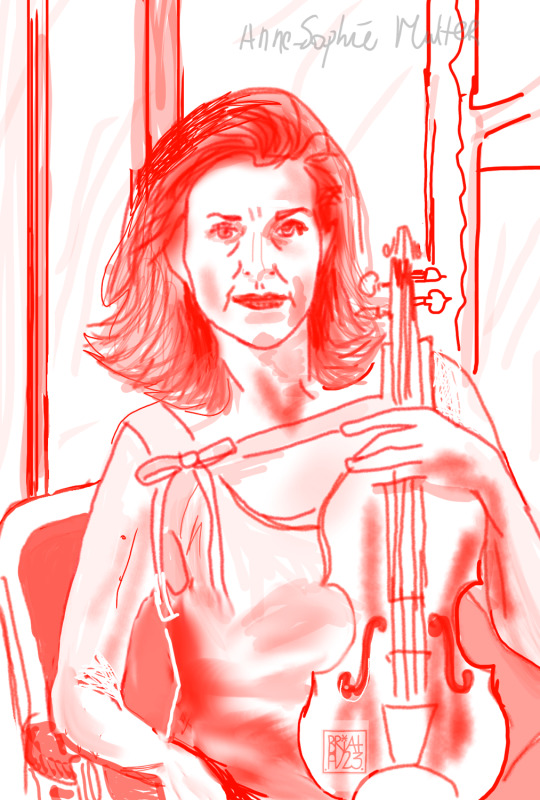
View On WordPress
1 note
·
View note
Text
Helena's Theme (For Violin and Orchestra) (From "Indiana Jones and the Dial of Destiny")
youtube
#Indiana Jones#Indiana Jones and the Dial of Destiny#John Williams#film music#Anne Sophie Mutter#Youtube
1 note
·
View note
Text
youtube
“Helena's Theme (For Violin and Orchestra)” from Indiana Jones and the Dial of Destiny (2023) – composed and conducted by John Williams; solo violin by Anne-Sophie Mutter
To the vocal consternation of many awards show fans (believing this score not original enough), John Williams snagged his 54th Academy Award nomination for his score to Indiana Jones and the Dial of Destiny. For those refusing to delve into film scores after watching films, that is their loss (there is a distinct lack of the Raiders' March and other familiar Indiana Jones motifs throughout). Perhaps the centerpiece cue of the film is "Helena's Theme", named after Indy's goddaughter played by Phoebe Waller-Bridge. Williams took inspiration for this theme from Waller-Bridge's in-person and on-screen persona, the latter of which reminded him of headstrong female characters such as Gene Tierney's title character in Laura (1944).
The leitmotif representing Helena is modified and repurposed across so much of Williams' score to Dial of Destiny in ways that recall the unabashedly romantic film score composing from Erich Wolfgang Korngold (1935's Captain Blood, 1940's The Sea Hawk) and David Raksin's score to Laura. Williams has rarely been able to channel this level of romanticism in a film score in some years ("Across the Stars" from Attack of the Clones, perhaps?).
Now 92 years of age (91 when he was nominated), Williams extended his own record of being the oldest-ever Oscar nominee in any category. He is the second-most nominated individual of all time (and most-nominated living person), behind Walt Disney's 59 nominations.
#Indiana Jones#Indiana Jones and the Dial of Destiny#John Williams#Anne-Sophie Mutter#Phoebe Waller Bridge#film score#OST#great film scores#96th Academy Awards#Oscars#31 Days of Oscar
4 notes
·
View notes
Text

Anne-Sophie Mutter, violinist
2 notes
·
View notes
Text
youtube
#star wars#music#head this on concert fm and it absolutely destroyed me#anne-sophie mutter is amazing#Youtube#john williams#that final note!!
2 notes
·
View notes
Text
The role of music in «Nec Deus Intersit»
Our story begins with a scene of the concert, held by a mysterious unnamed singer. I — the author of the story, Lunatic Sun — have decided to leave this character nameless. The music is the most important thing here. But the singer has two very specific, well-defined prototypes, and the music isn't fictional either. Let me tell you a story about it.
There was a 2.000 word limitation for each story, so I needed to cut all the classical melodies descriptions short. I imagined that during the concert the singer would start with some lyrics at first, and then the orchestra would join him.
The first chapter of «Nec Deus Intersit» is dedicated to the memory of Klaus Nomi. I also added special thanks for the inspiration and gratitude to Jakub Józef Orliński. You may guess that these two personas and their voices are interwoven in the image of the fictional singer. I’ve wanted to pay tribute to the talents of both of them for a long time.
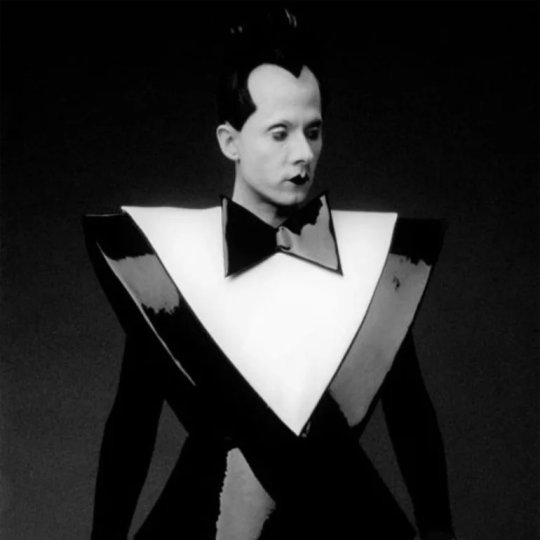
Klaus Nomi is noted to have a very tragic story and a huge talent. I'd love to think that in a world of the Arcana he would be perceived as a magnificent mysterious man, just like he was in his real life. I believe his talent was beloved even by such a demanding and old creature with an excellent taste in arts as Valdemar.
N.B.: I'm absolutely sure that Valdemar is completely charmed by the music. There is a mention of them singing as they leave the Dungeons in the Julian’s route.
If you'd like to learn more about Klaus Nomi's recordings and learn his story, you can visit his official channel or watch the documentary «The Nomi Song» (2004) by Andrew Horn.
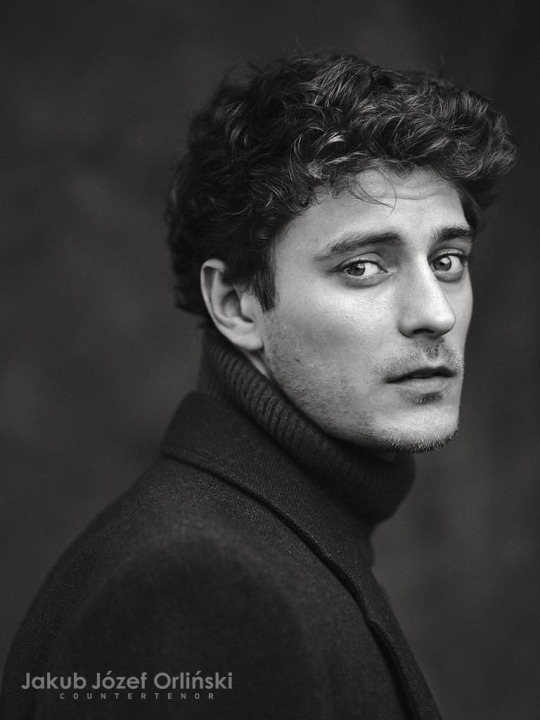
Jakub Józef Orliński (Polish opera singer, countertenor) amazes with his vocal skills. Just like Klaus Nomi, he has a strong part of drama in his singing. You can find his official YouTube channel here.
***
And now let’s have a look at the music mentioned in the scenes, in the order of its appearance.
N.B.: I believe that Julian (looking to the Heartsong festival as a canon) with all his love for the opera wouldn't be able to stay untouched by this music.
Vivaldi: Il Giustino, RV 717, Act 1: "Vedrò con mio diletto" (Anastasis)
youtube
In my humble opinion, this particular performance of this Vivaldi’s aria is truly unsurpassed. Jakub Józef Orliński has a really strong emotional voice, and even if you are not familiar with the Italian language, there would be no language barrier at all. This is what I call a fabulous drama.
Vivaldi: Le quattro stagioni, Concerto No. 4 in F minor, Op. 8, RV 297, "Winter" (L'inverno): Allegro non molto
youtube
The second piece is «Allegro non molto» from Vivaldi’s group of violin concertos «Four seasons». Surely it has been performed numerous times before, but my heart belongs to Anne-Sophie Mutter due to her energy and agility. In her version you can feel all the expressiveness Vivaldi put into his work. In my perception of the «Nec Deus Intersit» story this masterpiece should sound just like that.
Henry Purcell: King Arthur, Act 3, Scene 2. "What Power Art Thou?" (The Cold Song)
Let’s have a look at the piece that sounded after the intermission and that excited Julian so much.
It's «The Cold Song» from the semi-opera «King Arthur» by Henry Purcell. The Cold Genius sings this aria when his eternal peace is disturbed by Cupid.
It was Klaus Nomi who made this song — originally performed by basso voices — so popular with the countertenors. Countertenors, in my humble opinion, added more drama to this song. Moreover, it made it possible to rethink the image of the Cold incarnation itself — instead of the ancient elder, as it was in the opera, there is an ancient, immortal and sexless being who rejects this world and prefers eternal sleep in the ice.
youtube
Here you can find a revolutionary performance by Klaus Nomi (particularly dramatic if you know his story).
youtube
And here is a performance by Jakub Józef Orliński.
Hasse: Oratorio Sacro in Due Parti: Sanctus Petrus et Sancta Maria Magdalena. "Mea tormenta, properate"
Furthermore, in the next chapter Valdemar mentions the aria «Mea tormenta, properate» from the oratorio "Sanctus Petrus et Sancta Maria Magdalena" by Johann Adolph Hasse. Here again — a performance by Jakub Józef Orliński.
youtube
Valdemar pointed out that the message of this aria suits Julian perfectly. This is not accidental, if you have a look at the text:
Mea tormenta, properate,
Ubi sunt flagella et caedes, ubi sunt flagella et caedes?
Crucem quaero, crucem date
Volo mori, o Deus in te, volo mori, o Deus in te, o Deus in te…
(Translation)
My torments, hurry,
Where are the scourges and their lacerating teeth?
I want to be crucified, crucify me,
I want to die; oh God, in you I want to die.
How would the entire concert sound? Every time I imagine it a little bit differently, especially if I hear the perfect (in my humble opinion) performance of some classical pieces. The concert may include "Adagio from concerto №3 in D minor, BWV 974" and "Sarabande" by George Frederick Handel, "From beyond" and "Death" by Klaus Nomi, "Music for a while" by Henry Purcell. But the works mentioned above are quite special and essential to this story. It was the music which was the main source of inspiration in some ways. So, if someone decides to listen to them, most likely, they will not regret.
I still pay my respects to Klaus Nomi and Jakub Józef Orliński.
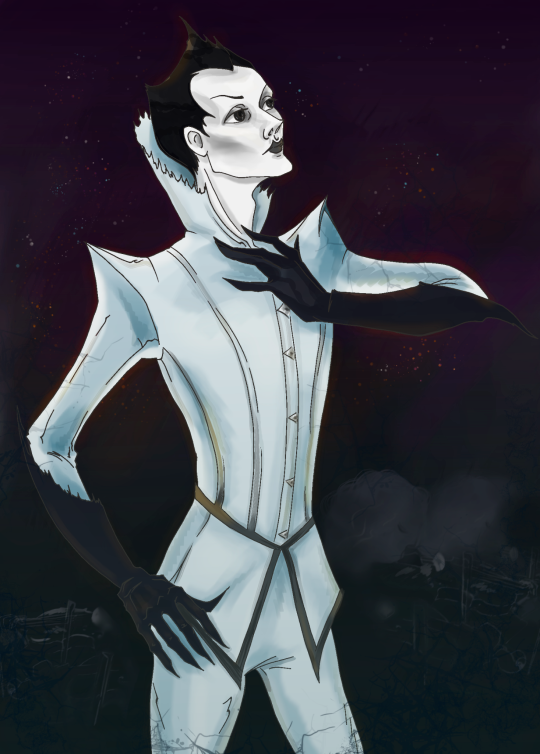
art: Chilledoutbeast/LunaticSun (main line/back+colour)
#the arcana#the arcana game#the arcana fanart#the arcana headcanons#the arcana julian#the arcana valdemar#quaestor valdemar#julian devorak#classical music#dorian writes#jakub józef orliński#klaus nomi#Julian x Valdemar#antonio vivaldi#Ann-Sophie Mutter#Nec Deus Intersit#the Arcana fanfiction#the arcana original character#avantgarde#Youtube#lunatic talks#macabre arts
6 notes
·
View notes
Text
Karajan: a new film – and the controversy continues
Tom Service
The Guardian
London, UK
Thu 4 Dec 2014 @ 03:00 EST
The conductor – who led the Berlin Philharmonic from 1956 to 1989 – is the subject of a new BBC documentary. But he remains an enigmatic figure, whose musical approach sounds a false note in today’s world.
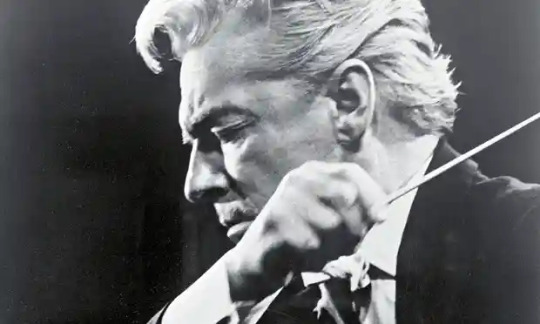
📸 Visionary? Conductor Herbert von Karajan in 1976. Photograph: Bettmann/Corbis
Herbert von Karajan. He’s both an icon and an enigma in the story of 20th century music. Baton aloft, hair expertly coiffed, shot in soft-focus lighting from the left (he insisted he was photographed from what he thought was his best side), he is the familiar face of millions of records, videos, laserdiscs, and now DVDs and downloads, the person who arguably did more to turn symphonic music into a commodity in the postwar era. He is also the despotic maestro of imperialistic ambition, who wanted to conquer every available media possibility and turn them into publicity-generating – and commercially lucrative – opportunities for him and his orchestra, the Berlin Philharmonic.
But Karajan the man remains elusive: a conductor who didn’t – and possibly couldn’t – form friendships with the musicians he led for more than 30 years, whose political past (he was a member of the Nazi party) was a dark halo over his reputation throughout his life, and whose music-making itself, for all its gigantic success, has now become a legacy that most of today’s conductors openly repudiate. Karajan’s approach, they say, represents an ideology in which the superficial gloss, finish and perfection of orchestral sonority is an end in itself, a one-size-fits all solution for repertoires from Bach to Berg, from Mozart to Mahler, which ironed out the expressive edges of everything he conducted. Simon Rattle, for one, has talked about how he was “slightly repelled” by the Karajan sound when he heard it in the flesh for the first time, and he’s just one conductor who feels that Karajan – “the emperor of legato” – belongs to a musical world that has no place in today’s orchestral culture.
It’s all of those myths, cliches, and phenomena that John Bridcut’s new film – Karajan’s Magic and Myth, broadcast on BBC4 on 5 December – interrogates, in the BBC’s first commissioned film on the conductor, 25 years after his death. There are some fascinating moments: interviews with musicians from the Philharmonia in London in the early 1950s, from the Berlin Phil, fellow conductors Nikolaus Harnoncourt (who played as a cellist for Karajan in the Vienna Symphony Orchestra) and Mark Elder, and a handful of the starry soloists he worked with in the later stages of his career, Placido Domingo, Anne-Sophie Mutter, and Jessye Norman.
Most illuminating of all are the glimpses you’re given of a man and musician who didn’t conform to the one-dimensional caricature he has become for some: far from a dead-eyed perfectionist, Karajan actually ignored obvious imperfections, such as a magnificently obdurate fluffed note from the fourth trumpet in one of his recordings of Strauss’s Alpine Symphony, in favour of the overall sweep of a longer take in the studio – or possibly because it was cheaper not to patch it up.
Karajan’s undoubted vanity comes over as one of the strongest indictments of his personality: not just the whole left-side-is-my-best-side thing, but making sure that his principal flute James Galway wasn’t visible in his films, because Karajan didn’t like Galway’s facial hair. Conversely, he didn’t like baldness either in himself or his orchestral players, and he made follicly challenged musicians wear wigs for the filmed sessions – even if they were often invisible since the camera focused for the vast majority of the time on Karajan and his closed-eye conducting, and on the instruments rather than the actual players.
But the biggest issue of all, the question of how Karajan actually produced the performances he did, remains unanswered in Bridcut’s film, as it does in the other Karajan documentaries that have been made. There are the crazy facts of his contract with the Berliners – that they were to be at his beck and call around the clock whenever he was in Berlin, summonable at a moment’s notice for a recording, rehearsal, or film session – but even accounting for Karajan’s famed magnetism and charisma on the podium, it’s hard to completely understand how he was able to command such complete authority over his musicians and orchestral culture all over the world.
It’s possible that Karajan is a phenomenon that today’s musical culture just couldn’t tolerate (although the fetishisation of the conductor figure continues unabated; just think of the adulation, marketing and hype around Gustavo Dudamel, for example), but the other side of it is the sheer scale of Karajan’s achievement. In rejecting Karajan’s recordings, we risk underestimating both the sheer intensity and indelible power of the sound world he created, and the sophistication of what he was doing musically. He also made visionary use of the latest media.
A few examples: watch his films with Henri-Georges Clouzot, rehearsing and performing Schumann’s Fourth Symphony and Beethoven’s Fifth. Karajan and Clouzot turn the art of orchestral rehearsal and music analysis into sensual filmic experiences. Of course, Karajan is performing for the cameras, but the substance of what he is saying when he tutors the hapless student conductor is rivetingly insightful, as is his forensic, multi-dimensional explosion of the start of Schumann 4.
These are suggestions (and there are others in the surprising amount of Karajan rehearsal footage on YouTube) of an essential approach to music-making, a way of building an orchestral score and a symphonic sound world from the bottom up, so that the symphony or opera or tone poem is generated from the basics – and the bass lines – of its harmonic momentum.
Karajan seemed to feel each piece he conducted as a single sweep of musical momentum made up of interconnecting lines of melody and harmony. His closed eyes, by the way, aren’t only about a mystical communion with an internal world of the music (and an incomprehensible mode of communication for Simon Rattle, and most other conductors), but a way of recalling the score, which, it’s said, he could see in his mind’s eye, turning the pages in his imagination. He had to keep them shut, otherwise he would lose his concentration.
But it’s his physical gestures that really tell this story of what he’s doing. So often, Karajan is reaching down with his hands, moulding and kneading a kind of sonic plasma that seems to begin somewhere beneath his podium, in the bowels of the earth – or at least with the Berlin Phil’s double bass players – and emerges upwards with volcanic force. That’s why his Bruckner, his Brahms, his Sibelius, his Wagner is so thrillingly powerful, because the music seems to be made of elemental energy, not simply orchestral sonority.
Well, that’s how it seems to me when Karajan is at his best – you can hear that too, in Karajan’s essential years with the Philharmonia in the 1940s and 50s; the Beethoven cycle they made together is arguably the most exciting of all his Beethovenian surveys. And it’s worth remembering how radical Karajan’s experiments with music and film were: yes, the fixed rows of musicians seem uncomfortably like a musical-modernist version of a Riefenstahl-like sense of order and abstraction, but they are achieved with a remarkable sense of filmic possibility, and with the essential idea that classical music on film should not simply be a filmed version of concerts, but a new medium, a new kind of experience.
The best of all is a film that Karajan didn’t like, directed not by the maestro himself but by Hugo Niebeling. It’s a version of Beethoven’s Pastoral Symphony, made in 1968, in which the cinematography is as powerful an interpretation of the piece as the performance, so that you feel the storm and the stream, the architecture and the physicality of Beethoven’s music with your eyes as well as your ears. Forty-six years after it was made, it’s a film that is infinitely more radical than the vast majority of classical music films made today.
A quarter century on from his death, Karajan remains a seismic figure in classical music, and even in a film of the range of Bridcut’s, the man himself remains hard to fathom. But as a new generation of listeners discover his legacy, especially in China and Japan, where his records still sell as the acme of classical music, he’s an unavoidable presence. In the questions that his life and music-making pose, you might not like him, but you have to deal with him. The Karajan controversy continues.
Karajan’s Magic and Myth is on BBC4 at 730pm on Friday 5 December, and then on iPlayer until 4 January.
#Herbert von Karajan#Berlin Philharmonic#Jessye Norman#Gustavo Dudamel#Placido Domingo#Anne-Sophie Mutter#Henri-Georges Clouzot#Hugo Niebeling#Bruckner#Brahms#Sibelius#Wagner
4 notes
·
View notes
Text
Rheingau Musik Festival 2024 - Manfred Honeck e Anne-Sophie Mutter
Foto ©Christian Palm Photographie
A distanza di una settimana ho voluto fare un secondo viaggio a Wiesbaden per assistere al concerto della Pittsburgh Symphony Orchestra,
Continue reading Rheingau Musik Festival 2024 – Manfred Honeck e Anne-Sophie Mutter

View On WordPress
#adams#anne-sophie mutter#critica#honeck#kurhaus#mahler#mendelssohn#musica contemporanea#pittsburgh symphony orchestra#rheingau musik festival#sinfonica#strumentale#wiesbaden
0 notes
Text
Happy birthday Anne-Sophie Mutter
0 notes
Text
Anne-Sophie Mutter :Vivaldi The Four Seasons LP Version
youtube
0 notes
Text
On The Jukebox: “Indiana Jones And The Dial Of Destiny (Original Motion Picture Score)”

Original music composed by John Williams. Featuring violin from Anne-Sophie Mutter on “Helena’s Theme (For Violin And Orchestra)”
0 notes
Text
Anne-Sophie Mutter wordt zestig...
Vandaag wordt violiste Anne-Sophie Mutter zestig jaar.
Continue reading Untitled

View On WordPress
0 notes
Text
tartini’s violin sonata in g minor “devils trill sonata”?? that shit bro??…..it does something to me
#uuuummmm only as played by anne-sophie mutter tho…..everyone else can leave#isaspeaks#out of bounds
1 note
·
View note